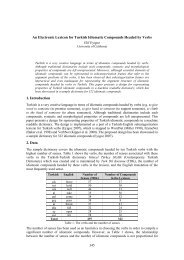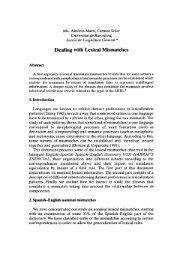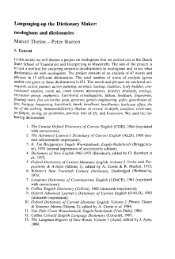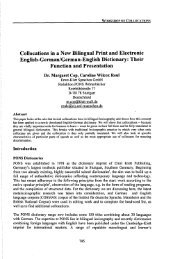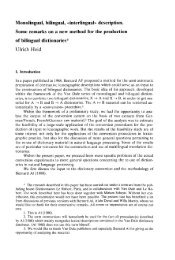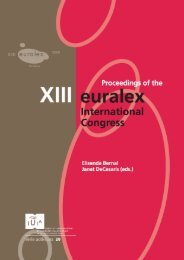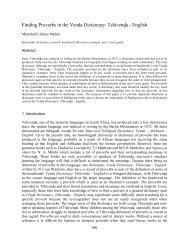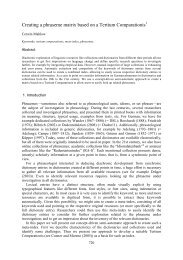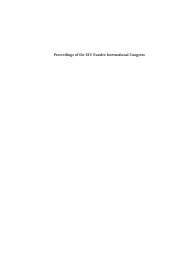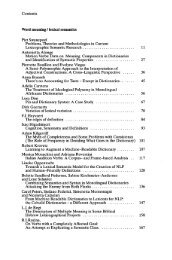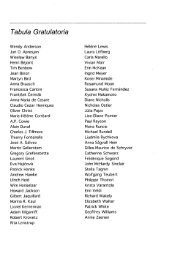Mary Snell-Hornby THE BILINGUAL DICTIONARY - HELP ... - Euralex
Mary Snell-Hornby THE BILINGUAL DICTIONARY - HELP ... - Euralex
Mary Snell-Hornby THE BILINGUAL DICTIONARY - HELP ... - Euralex
Create successful ePaper yourself
Turn your PDF publications into a flip-book with our unique Google optimized e-Paper software.
<strong>Mary</strong> <strong>Snell</strong>-<strong>Hornby</strong><br />
<strong>THE</strong> <strong>BILINGUAL</strong> <strong>DICTIONARY</strong> - <strong>HELP</strong> OR HINDRANCE?<br />
Introduction<br />
Throughout its history, the conventional bilingual dictionary<br />
has been based on a principle which is now being increasingly<br />
probed and called into question: that of interlingual equivalence.<br />
Until recently, the concept of equivalence was taken for granted,<br />
and it was for some years a focal concern in translation theory.<br />
It is however a highly problematic concept, and one may ask whether<br />
the expectation of equivalence does not hinder rather than further<br />
the processes both of translation and of language learning. In<br />
denoting equality of meaning, semantic equivalence involves the<br />
confrontation of lexemes as units in a vocabulary list, a startingpoint<br />
which tends to falsify lexical relations within most language<br />
pairs, even with two such closely related languages as English<br />
and German.<br />
In making these statements, I would however like to point<br />
out that they do not apply equally to all types of lexeme or<br />
to each type of dictionary. And secondly, 1 must stress right<br />
away that I am not a lexicographer, and that this paper is based<br />
on my experience in translating and language teaching at advanced<br />
university level, as well as on research in contrastive lexicology,<br />
whereby the emphasis falls heavily on the epithet 'contrastive'<br />
rather than on the study of isolated lexemes. Indeed, like<br />
Hartmann, Neubert and many others professionally interested in<br />
translation studies, I have - since carrying out the work<br />
described here - widened my scope of study from the word to the<br />
text; my rather uneasy relationship to the bilingual dictionary<br />
stems from the fact that it operates with lexemes in isolation<br />
but actually functions for words in individual texts and in varying<br />
contexts.<br />
It is the purpose of my paper, firstly, to point out where<br />
the conventional bilingual dictionary can be a hindrance rather<br />
than a help to the user, and secondly, to suggest an alternative<br />
method of interlingual coordination of the types of lexeme<br />
concerned.<br />
The bilingual dictionary and its user<br />
Hartmann's recent survey of the use of dictionaries by learners<br />
of German in Southwest England (Hartmann 1982 and forthcoming)<br />
indicates that the general bilingual dictionary tends to be the<br />
language learner's favourite tool, especially for checking meaning,<br />
grammar and use in context of the foreign lexeme. This means<br />
that the vocabulary of the foreign language is internalized and<br />
interpreted, not against its own social and cultural background,<br />
but in terms of suggested dictionary equivalents in the native<br />
language. Furthermore, the' most popular activity for which the<br />
bilingual dictionary was used turned out in Hartmann's survey<br />
to be translation, both from and into the foreign language.<br />
J
In contrast to that, I would like to point out that in the<br />
training of professional translators the general bilingual dictionary<br />
is rather discouraged, and in my experience onlymonolingual<br />
dictionaries are permitted for use in examinations. This would<br />
indicate that the glib labelling of the general bilingual dictionary<br />
as the "translator's dictionary' is erroneous. Indeed, bilingual<br />
lexicography requires a good deal of differentiation,<br />
as regards its varied purposes and types of user, and according<br />
to its lexical content. For tourists, for example, the small pocket<br />
dictionary will remain indispensable; for technical terminology<br />
and standardized concepts ,the bilingual dictionary seems the<br />
optimal solution; for the language learner, up to a certain level<br />
of competence, specially adapted bilingual dictionaries would<br />
be invaluable.<br />
In this paper 1 would like to concentrate on an area which<br />
I have discovered by experience and confirmed by empirical research<br />
to be unsatisfactorily treated in the general bilingual<br />
dictionary. This is especially the case with those lexemes in<br />
everyday language that reflect the perception and evaluation of<br />
the speaker and involve culture-specific factors or relationships<br />
to personal or socially set norms. Such lexemes are usually distorted<br />
by approximate renderings in the form of rough equivalents<br />
and require a high degree of 'delicacy' (cf. Halllday 1976:72)<br />
in their analysis. Our envisaged user is therefore the translator,<br />
the foreign language teacher, or the advanced student at university<br />
level.<br />
The descriptive verb<br />
As a prototype of this problematic area of vocabulary, I would<br />
like to take a type of verb immediately recognizable to the experienced<br />
translator as a chronic source of difficulty, which I have<br />
identified as the 'descriptive verb' (<strong>Snell</strong>-<strong>Hornby</strong> 1983). Typical<br />
examples in English are bustle, nag, prowl and gleam, and in<br />
German huschen, keifen and scheppern. The descriptive verb centres<br />
particularly ôn fields of human Behaviour and activity, as well<br />
as on verbs expressing perception, mainly of sound, light, movement<br />
and speed. In semantic terms, it can be broadly defined as<br />
a structure focussing not on the verbal action itself, but on<br />
a complex of modifying elements describing the manner in which<br />
the action is carried out, evaluated or perceived, whereby one<br />
of the participants in the action is characterized by the speaker.<br />
This complex of elements expressing characterization or mode of<br />
perception is realized in the verb's basic definition by 'dynamic<br />
adjectives' which are, firstly, susceptible to subjective measure<br />
and secondly, gradable, expressing relative value that can be<br />
judged in terms of an implied and accepted norm (cf. Quirk et<br />
al. 1972:265). As examples let us take English bustle, characterizing<br />
human activity, and German huschen, expressfhg perception<br />
of movement. (My source texts are literary works by Boll, Durrell,<br />
Frisch, Heym, Isherwood, Masters and O'Brien.) In bustle, the type<br />
of verbal action is left open, as in the following example:<br />
(la) He recalled an aimless bustling in the night, but now<br />
all was in order.<br />
This must where necessary be specified by the context:
- 276 -<br />
(lb) The once cavernous and deserted kitchens were now full<br />
of the echoing bustle of servants preparing for a new<br />
feast or clearing up after one which had ended.<br />
Focal in bustle is the descriptive element of energetic, feverish<br />
or noisy activity, often to no apparent purpose. German huschen<br />
focusses on rapid and usually silent movement typically experienced<br />
by the speaker as being somewhat uncanny. It can describe the<br />
movement of a small animal, as in (2a).<br />
(2a) Mit einem kleinen und fast liebevollen "Flapp" raschelte<br />
das Gescho0 in die spröde Erde. Es erinnerte mich oft<br />
an das bescheidene und fast lautlose Huschen einer<br />
Feldmaus, die an einem stillen Nachmittag über den Weg<br />
lauft.<br />
or of shadows or objects in the distance:<br />
(2b) Reinhardt fuhr gern durch die Stadt. Uber Moenkebergs<br />
breiten Rücken hinweg konnte er die alten H'âuser Prags<br />
vorbeihuschen sehen. Moenkeberg fuKr immer mit überh'óhter<br />
Geschwindigkeit.<br />
A problem for bilingual lexicography is that, like most other<br />
descriptive verbs, neither bustle nor huschen have a satisfactory<br />
lexical equivalent in the other language. In the traditional<br />
bilingual dictionary this problem is solved basically in two<br />
ways:,.either by general paraphrase - for bustle LANGENSCHEIDT'S<br />
HANDWÖRTERBUCH offers gesch'àftig tun and Betrieb machen - or by<br />
a list of frequently uncommented synonyms - for s^hIeudern,<br />
for example, CASSELL'S <strong>DICTIONARY</strong> suggests sling, catapult, fling,<br />
throw, hurl, toss, project, send, shoot ', dart, reminding one<br />
of Samuel Martin's scathing comment made over twenty years ago:<br />
And sometimes the uncritical heaping up of near-synonyms<br />
is simply an evasion of responsibility on the part qf the<br />
dictionary-maker: unable (or too little informed) to make up<br />
his own mind, he shifts the burden of choice to the user of<br />
the dictionary. (1962:156)<br />
With these words of criticism I by no means wish to belittle<br />
the effort and the years of hard work that go into making a<br />
dictionary, but I would plead for new concepts and new methods<br />
of description and presentation. And in all fairness I must add<br />
that more recent dictionaries, such as COLLINS GERMAN-ENGLISH<br />
ENGLISH-GERMAN <strong>DICTIONARY</strong>, do provide more examples and more<br />
precise indications of context than the older dictionaries did,<br />
although this tends to inflate the size of the work considerably.<br />
Paradigmatic analysis and extent of coverage<br />
Before going into these problems, I would like to refer briefly<br />
to some results of a pilot study I carried out at Zürich University,<br />
testing the competence of 12 German-speaking students of<br />
English in translating descriptive verbs from German to English<br />
under varying conditions (<strong>Snell</strong>-<strong>Hornby</strong> 1983:216 ff.), whereby<br />
the number of translation errors varied, not so much among the<br />
students as with the semantic relationships existing between the<br />
J
German and English lexemes concerned, and also with the function<br />
of the verb in the text. Furthermore, and for this paper most<br />
significant: the number of errors did not depend on whether the<br />
use of a dictionary was permitted, although the type of information<br />
found in the dictionaries was crucial. The monolingual dictionaries<br />
were found to provide reliable, if sometimes incomplete information,<br />
while the bilingual dictionaries proved unsatisfactory. This<br />
was due especially to the uncommented lists of synonyms mentioned<br />
above, which only provide real help in jogging the memory of<br />
the bilingual user already familiar with them. In this case the<br />
suggested English equivalents^were usually unknown to the students,<br />
who said they often chose at random. Far more successful was<br />
a specially worked out form of guided help, whereby the English<br />
verbs were arranged in paradigms and their components analyzed<br />
to reveal the crucial points of differentiation between them<br />
and indicate their typical collocations or realization in a<br />
context.<br />
I would like to illustrate this by analyzing the three close<br />
English synonyms hurl, fling and toss, all of them equated in<br />
the five bilingual rTictionaries I checked 2<br />
with schleudern and<br />
werfen. In their transitive usage, hurl, fling and toss all<br />
describe specifically modified acts of throwing, the main differences<br />
between them being seen in the force of the movement and<br />
in the weight of the object thrown. Hurl focusses on violent<br />
movement, usually of a heavy object:<br />
(3a) Bedsteads, cupboards, sofas were propelled out upon<br />
the balcony and hurled from there into the courtyard.<br />
Fling indicates impulsive or angry movement without specification<br />
ot the object:<br />
(3b) (i) Meanwhile, Otto had flung himself upon Arthur<br />
like a young bear.<br />
(ii) He tugged the ruby from his finger and flung<br />
it at her.<br />
Toss focusses on careless or nonchalant throwing, typically of a<br />
light object:<br />
(3c) They drank. They smoked. All twelve smokers tossing<br />
the butts on to the tiled roof that sloped towards<br />
the farm buildings.<br />
German schleudern, on the other hand, expresses vehement movement<br />
and focusses on the sweeping movement of the arm, typically<br />
designed to send the object, whose size and weight is left open,<br />
over some distance:<br />
(3d) Offenbar hatte sie erwartet, dass ich aufspringe und<br />
Steine schleudere, um die Leute zu vertreiben wie<br />
eine Gruppe von Ziegen.<br />
Having stressed these common components and points of differentiation,<br />
described by Leisl (1962) as "Zonen der Deckung" and<br />
"Zonen der Verschiedenheit", we can see that such lexemes are
- 278 -<br />
more adequately compared in terms of extent of coverage than<br />
confronted as suggested equivalents: indeed, if we can talk of<br />
lexical equivalence here, then only in concrete terms as specified<br />
by the function of the lexeme within a particular co-text . For<br />
example, in (3d) above, fIing may be seen as a satistactory functional<br />
or working equivalent of schleudern, also schleudern of<br />
hurl in (3a), but not of fling in ~ГЗ~Ъ~Т. It cannot However be<br />
the"realistic aim of the generiT bilingual dictionary to anticipate<br />
all the possible functions and usages in context of the lexemes<br />
listed, although ironically this seems to be what a long list<br />
of synonyms vainly attempts to do.<br />
Model for a contrastive dictionary of synonyms<br />
I would therefore propose that the conventional bilingual<br />
dictionary be supplemented by segmental, purpose-specific contrastive<br />
dictionaries of synonyms, whereby the alphabetical system<br />
gives way to arrangement in semantic fields (cf. Hayakawa 1971;<br />
Martin 1984 in this volume). The underlying principle would be<br />
definition by comparison and contrast, both paradigmatically<br />
or intralingually (as I have attempted to do above with the paradigm<br />
hurl/fling/toss ) , and contrastively or interlingually, as<br />
attempted above with the introduction of schleudern. The definitions<br />
should be supported by examples from autTTentic texts. In<br />
an analysis of 1100 German and English descriptive verbs (617<br />
in English and 483 in German) arranged in 53 semantic fields,<br />
I have presented such a contrastive study of synonyms as reference<br />
material for translators, language teachers and students (<strong>Snell</strong>-<br />
<strong>Hornby</strong> 1983).<br />
I would now like to outline a model for comparing and contrasting<br />
synonyms in the way I envisage, but due to the limited<br />
space, I shall take some relatively simple and extremely common<br />
lexemes: some basic adjectives in English and German denoting<br />
physical size. The analysis of each field in the proposed model<br />
would consist of four parts:<br />
(1) a graphic representation of the field;<br />
(2) a brief survey of the structure of the field;<br />
(3) a description of the lexemes by contrastive definition;<br />
(4) examples from authentic texts (not translated and not<br />
involving idiosyncratic usage).<br />
Firstly, the graphic representation (Part 1 of the model):<br />
3<br />
Basic adjectives denoting physical size (extract)<br />
great<br />
huge<br />
tall ^ big<br />
large small<br />
little<br />
riesig<br />
t<br />
gross ч<br />
klein
- 279 -<br />
This basic system aims at maximum simplicity and flexibility:<br />
the paradigms are represented in columns, the gaps with arrows<br />
indicating a transition or shift in perspective; horizontal arrows<br />
between the columns indicate a change in physical dimension. The<br />
structure of the field of size (Part 2), as represented by this<br />
sample, can be described as follows:<br />
The adjectives presented here all denote size relative to a<br />
hypothetical norm represented on the diagram by 0: lexemes to<br />
the left of 0 denote size exceeding this norm, those to the<br />
right, size falling short of it. The columns are arranged<br />
in descending order of size.<br />
The main section with the contrastive definitions (Part 3) would<br />
run as follows, and for clarity and brevity I have here included<br />
a few very simple examples (Part 4) within the text - authentic<br />
examples with the necessary co-text are usually longer and more<br />
complex, and hence should normally be listed separately as footnotes<br />
(cf. <strong>Snell</strong>-<strong>Hornby</strong> 1983:89 ff.):<br />
Large and small are antonyms indicating objective measure<br />
of size in excess of and in default of 0 respectively; these<br />
are the terms used in trade and official reports. Big and<br />
little are likewise antonyms indicating subjective impression<br />
o"f iTze; these are the words used in everyday language, by<br />
small children, in an emotive context, or to indicate a general<br />
impression. In an unstressed position, big can have an<br />
augmentative function ("Look at that greatbig dog!"), and<br />
little a diminutive function ("Look at that dear little<br />
puppy !") . In contrast to English, German has only one pair<br />
of antonyms, groft and klein, expressing both objective<br />
measurement and subjective impression of size. Gro@ has<br />
no augmentative function; this is expressed in German by<br />
compounds, e.g. Riesen- or riesengroft . Groft also extends<br />
to tall in expressing measurement ot human height. Great on<br />
the other hand indicates a subjective impression of extreme<br />
magnitude, either concrete ("He felt lost in the great city")<br />
or abstract, indicating evaluation ("Shakespeare was a great<br />
dramatist"). German riesig expresses the subjective impression<br />
of extreme magnitude only in the concrete sense ("Tokio ist<br />
eine riesige Stadt"), whereby it has the emphatic colloquial<br />
function of English huge. The abstract sense of extreme<br />
magnitude, on the other hand, is expressed by gro p ("Er war<br />
ein groPer Schriftsteller").<br />
Conclusion<br />
This short description obviously could not aim at exhausting<br />
all the semantic and syntactic properties of the lexemes concerned,<br />
and the problem of maximum economy in presentation also remains<br />
to be solved, but I hope to have given some evidence for my conviction<br />
that the bilingual dictionary will not fulfil its function<br />
completely if it remains merely a repository of isolated lexemes<br />
and static equivalents - it also needs to reveal the dynamic<br />
system of relationships within and between languages, the function<br />
of words in their contexts, and the interdependence of language,<br />
culture and social interaction.
- 280 -<br />
In browsing through some of the conventional bilingual dictionaries<br />
now on the market, I am frequently reminded of Hamlet's<br />
famous answer when Polonius asks him (Act II, Scene 2) "What<br />
do you read, my lord?", and it runs, "Words, words words". And<br />
when Polonius insists, "I mean, the matter that you read, my<br />
lord", Hamlet replies, "Slanders, sir", and with those two rejoinders<br />
he highlights the difference between the (empty) word and<br />
the meaningful text. Fortunately of course, by no means all texts<br />
are slanderous, but a text is essentially a unit of communication<br />
and expression made possible by the infinite potential and the<br />
sometimes overwhelming complexity of language. And though there<br />
may often seem to the translator and the language student to<br />
be madness in that complexity, it is surely the main task of<br />
the lexicographer to elucidate the method in it.<br />
Notes<br />
^ I am here referring specifically to the Institut fur Übersetzen<br />
und Dolmetschen, University of Heidelberg, but a similar<br />
practice was confirmed by other institutions at the AILA<br />
colloquium on Translation Studies (Saarbrücken, July 1983).<br />
2<br />
3<br />
These dictionaries were: CASSELL'S <strong>DICTIONARY</strong> (1978), COLLINS<br />
GEM <strong>DICTIONARY</strong> (1978), Schöffler-Weis KLETT/HARRAP <strong>DICTIONARY</strong><br />
(1969), Langenscheidt's HANDWÖRTERBUCH (1977), and Wildhagen<br />
BRANDSTETTER/ALLEN & UNWIN <strong>DICTIONARY</strong> (1972).<br />
This is an extract from work done with students at the University<br />
of Berne, as described in <strong>Snell</strong>-<strong>Hornby</strong> (forthcoming).<br />
Contrast these findings with statements made by Teller (1969:<br />
205 f.).<br />
References<br />
Halliday, M.A.K. (1976) System and Function in Language. Selected<br />
Papers ed. by G.R. Kress. London: Oxford U.P.<br />
Hartmann, R.R.K. (1982) "Das zweisprachige Wörterbuch im Fremdsprachenerwerb"<br />
in Studien zur neuhochdeutschen Lexikographie (Band<br />
II) ed. by H.E. Wiegand. Hildesheim-New York: Olms<br />
Hartmann, R.R.K. (forthcoming) "The bilingual learner's dictionary<br />
and its uses" Multilingua<br />
Hayakawa, S.I. ed. (1971) Cassell's Modern Guide to Synonyms and<br />
Related Words. London: Cassell<br />
Leisi, E. (1962) "Englische und deutsche Wortinhalte. Zonen der<br />
Deckung, Zonen der Verschiedenheit" Wirkendes Wort 12: 140-150<br />
Martln, L. (1984) "Lexical fields and stepwise lexical decomposition<br />
in a contrastive English-Spanish verb valency dictionary" in<br />
this volume<br />
Martin, S. (1962) "Selection and presentation of ready equivalents<br />
in a translation dictionary" in Problems in Lexicography ed. by<br />
F.W. Householder and S. Saporta. Bloomington: Indiana U.P.<br />
Quirk, R. et al. (1972) A Grammar of Contemporary English. London:<br />
Longman<br />
<strong>Snell</strong>-<strong>Hornby</strong>, M. (1983) Verb-descriptivity in German and English. A<br />
Contrastive Study in Semantic Fields. Heidelberg: Winter
- 281 -<br />
<strong>Snell</strong>-<strong>Hornby</strong>, M. (forthcoming) "Contrastive semantics: an empirical<br />
basis for guided student research" Neusprachliche Mitteilunqen<br />
Teller, P. (1969) "Some discussion and extension of Manfred Bierwisch's<br />
work on German adjectivals" Foundations of Language 5:<br />
185-217



